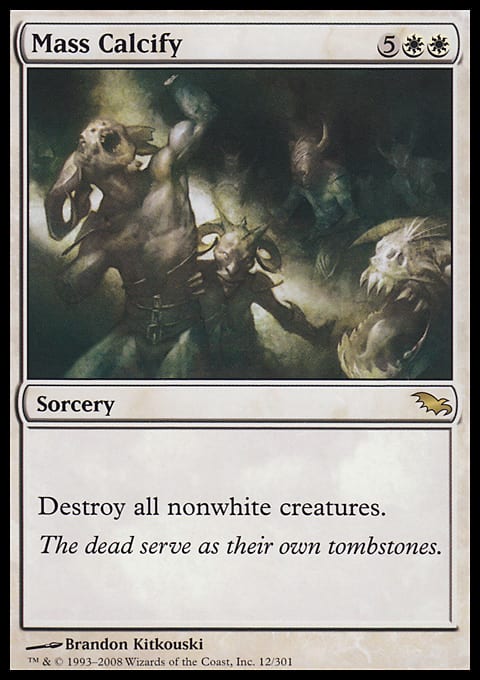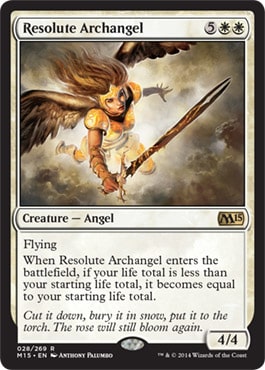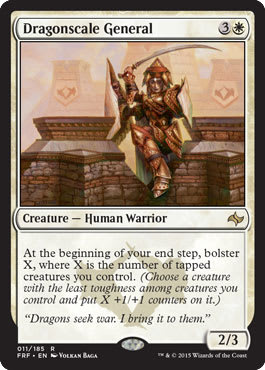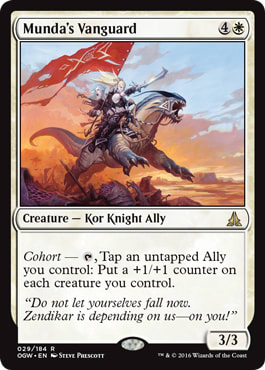Last week we kicked off a walk through the Preconstructed history of the game, this time through an Intro Pack lens. The B/W color pairing hasn’t always been the most common, but it’s yielded a number of interesting builds. We left off with Dragon’s Maze, which alongside Gatecrash gave a great deal of definition to what it meant to be “Orzhov proper.” The first time around in the original Ravnica block, we had a bleeder deck with the rather underwhelming haunt mechanic.
To trace the evolution of the pair, we’ll begin today with Theros block.
Year: 2013
Set: Theros
Deck: Favors from Nyx
Rares: Celestial Archon, Gift of Immortality
Favors from Nyx ? Intro Deck| Wizards of the Coast
- Creatures (22)
- 1 Auramancer
- 1 Baleful Eidolon
- 1 Banisher Priest
- 1 Blightcaster
- 1 Cavern Lampad
- 1 Celestial Archon
- 1 Erebos's Emissary
- 1 Minotaur Abomination
- 1 Pillarfield Ox
- 1 Scholar of Athreos
- 1 Sentry of the Underworld
- 1 Yoked Ox
- 2 Heliod's Emissary
- 2 Hopeful Eidolon
- 2 Lagonna-Band Elder
- 2 Observant Alseid
- 2 Traveling Philosopher
- Instants (6)
- 1 Doom Blade
- 1 Ray of Dissolution
- 2 Last Breath
- 2 Pharika's Cure
- Sorceries (2)
- 2 Vanquish the Foul
- Enchantments (5)
- 1 Gift of Immortality
- 1 Ordeal of Heliod
- 1 Pacifism
- 2 Ordeal of Erebos
“If you are patient,” counsels the deck’s strategy guide insert, “and wait to bestow your Celestial Archon on another creature, you make your opponent deal with it twice: once as an Aura and again as a creature.”
This is, of course, rather absurd. Bestowing the Archon costs 7 mana — being alive long enough to cast it isn’t entirely a matter of patience. And therein lies the problem with Favors from Nyx, which pairs a load of bestow creatures (from Hopeful Eidolon to Cavern Lampad) with, well, other bestow creatures (like Heliod's Emissary and Baleful Eidolon). Along the way, there are a few cards that actually seem to care about what you’re doing beyond just squeezing out extra utility from a subset of your cards.
Blightcaster gives you a repeatable debuff every time you cast an enchantment, which is very solid in a deck with enchantment creatures as well as other enchantments/Auras. Unfortunately, it only carries a miser’s copy, so it’s hardly reliable. You do, however, get a pair of Lagonna-Band Elders, which instead of potentially killing a hostile threat, simply give you 3 life.
In times past, particularly with Core Set Intro Packs, we often saw a “dominant” color supply all of the creatures, while the secondary color just contributed a handful of spells. It’s nice to see some growth in the card diversity, as Favors from Nyx draws upon both colors to field its troops, but overall there just wasn’t enough punch in the deck. This period of time had a lot of disappointing Preconstructed deck designs, and this deck does the set no favors (ha!).
Year: 2014
Set: Journey into Nyx
Deck: Pantheon’s Power
Rares: Doomwake Giant, Fate Unraveler
Pantheon?s Power ? Intro Deck| Wizards of the Coast
- Creatures (24)
- 1 Archetype of Courage
- 1 Archetype of Finality
- 1 Brain Maggot
- 1 Doomwake Giant
- 1 Eagle of the Watch
- 1 Fate Unraveler
- 1 Pharika's Chosen
- 1 Rotted Hulk
- 2 Akroan Mastiff
- 2 Dreadbringer Lampads
- 2 Grim Guardian
- 2 Harvestguard Alseids
- 2 Nyx-Fleece Ram
- 2 Odunos River Trawler
- 2 Thoughtrender Lamia
- 2 Underworld Coinsmith
- Enchantments (10)
- 1 Armament of Nyx
- 1 Aspect of Gorgon
- 1 Banishing Light
- 1 Cast into Darkness
- 1 Font of Return
- 1 Font of Vigor
- 2 Nyx Infusion
- 2 Oppressive Rays
I noted last week that while many sets avoided the B/W color pairing, those that featured it in one of their Preconstructed products often did again in the same block. Journey into Nyx is another example, as two sets later we’re back with more B/W enchantments.
The previous deck just threw a bunch of bestow creatures at you with little connection outside of a couple of cards. This time, however, there’s a little more cohesion to tie them all together in the constellation mechanic. The effect provided in Favors from Nyx in the Blightcaster is now a central mechanic to the set, which offers you additional value for casting many of the cards you were going to cast in the first place.
Eleven of the deck’s twenty-four creatures carry the keyword, and there are no stray instants, sorceries, or artifacts to get in the way of all your constellation triggers. All you have to play here are lands, creatures, and enchantments. With seventeen of the creatures being Enchantment Creatures, you’ll have no difficulty chaining a bunch of effects together.
And the payoff for all this focus? Mileage varies. On the one hand, you get some minor effects such as life loss or life gain in cards like Grim Guardian and Underworld Coinsmith, though even minor effects can pay off handsomely if deployed early enough in the game. Those looking for more robust effects can take heart, as the Doomwake Giant can brutalize an opponent’s board just as the Thoughtrender Lamia can nuke their hand.
And if the deck itself is fairly light on removal (Nyx Infusion, a singleton Banishing Light), well, that’s because you’ll be spending much more time developing your own board rather than worrying about your opponents. Decks like this can stall if you don’t find the right pieces, but the difference between this and the Theros deck are night and day.
Year: 2014
Set: Magic 2015
Deck: Price of Glory
Rares: Mass Calcify, Resolute Archangel
Price of Glory ? Intro Pack| Wizards of the Coast
- Creatures (22)
- 1 Accursed Spirit
- 1 Blood Host
- 1 Geist of the Moors
- 1 Kinsbaile Skirmisher
- 1 Resolute Archangel
- 1 Tireless Missionaries
- 1 Wall of Essence
- 2 Ajani's Pridemate
- 2 Child of Night
- 2 Shadowcloak Vampire
- 2 Sungrace Pegasus
- 2 Wall of Limbs
- 2 Witch's Familiar
- 3 Soulmender
- Instants (3)
- 1 Pillar of Light
- 2 Ulcerate
- Sorceries (5)
- 1 Mass Calcify
- 1 Solemn Offering
- 3 Sign in Blood
- Enchantments (3)
- 1 Crippling Blight
- 1 Divine Favor
- 1 First Response
- Artifacts (2)
- 1 Staff of the Death Magus
- 1 Staff of the Sun Magus
As noted last week, another pattern the B/W decks appeared to follow was the “every other year” Core Sets. While Magic 2013’s Sole Domination played with the returning exalted keyword, Price of Glory hearkens back to Magic 2011’s Blades of Victory.
That deck, while having a fairly straightforward setup common of Core Set Intro Packs, did include a bit of a twist with some lifegain and Ajani's Pridemate. It wasn’t a major feature of the deck, but the “lifegain matters” aspect was there.
This time around, it’s not just there — it’s pushed. Ajani's Pridemates are back, and they’re not alone. Wall of Limbs is an excellent card here, providing a sturdy blocker, a lifegain trigger, and a coup de grace to finish off a wounded opponent. Cards like Shadowcloak Vampire and Ulcerate unabashedly treat your life total like the additional resource it truly is, while First Response gives you a little extra incentive for some self-harm.
Meanwhile, there are plenty of opportunities to earn back that spent life. Creatures like Soulmender and Tireless Missionaries give you ways to up your life directly, while several other creatures (like the Child of Night and Sungrace Pegasus) offer lifelink as a way to gain life while engaging in the red zone. And if all that’s not enough, you also get a copy each of Staff of the Sun Magus and Staff of the Death Magus, the latest iteration of the longstanding “lucky charms” card type (lifegain tied to casting cards of a particular color). Finally, the deck’s premium rare Resolute Archangel lets you reset the clock when summoned.
This is a nice package that really fleshed out the potential that was illustrated in Magic 2011. Lifegain for its own sake is one of the more common traps in Magic, since it does little to actually change the reasons you need it in the first place. But when it’s connected to a raft of effects and triggers that help your deck punch above its weight, it can come together quite well.
Year: 2015
Set: Fate Reforged
Deck: Unflinching Assault
Rares: Cruel Sadist, Dragonscale General
Unflinching Assault ? Intro Pack| Wizards of the Coast
- Creatures (22)
- 1 Battle Brawler
- 1 Chief of the Edge
- 1 Chief of the Scale
- 1 Cruel Sadist
- 1 Dragonscale General
- 1 Elite Scaleguard
- 1 Gravedigger
- 1 Hooded Assassin
- 1 Merciless Executioner
- 1 Razorfoot Griffin
- 1 Unyielding Krumar
- 2 Abzan Skycaptain
- 2 Aven Skirmisher
- 2 Mardu Hateblade
- 2 Sandsteppe Outcast
- 3 Oreskos Swiftclaw
- Instants (7)
- 1 Sandblast
- 1 Take Up Arms
- 1 Throttle
- 2 Harsh Sustenance
- 2 Honor's Reward
- Sorceries (2)
- 1 Diplomacy of the Wastes
- 1 Rush of Battle
- Enchantments (4)
- 2 Debilitating Injury
- 2 Raiders' Spoils
- Lands (25)
- 13 Plains
- 9 Swamp
- 3 Scoured Barrens
Although you could make a case that a deck filled with “Enchantment Creatures” felt akin to tribal, the last time we saw a true B/W tribal deck was back in 2002 with Onslaught’s Cleric-driven Ivory Doom. This time, we’re putting down the maces and picking up the swords with the Warrior-centric Unflinching Assault.
Dragons of Tarkir block stuck the Warriors in interesting territory. Nearly a decade ago, Morningtide took the concept of “class” characteristics wide, a step behind the race-based Lorwyn. Warriors were one of the five class types standardized in the set, alongside Soldier, Shaman, Wizards, and Rogues. Curiously, while Lorwyn, Shadowmoor, and Eventide all had five Theme Decks, Morningtide offered only four, each based around a class and with Wizards getting the cold shoulder. At that time, Warriors were firmly in R/G territory.
What a difference time can make! Unflinching Assault packs in a ton of Warriors, from Aven Skirmisher to Unyielding Krumar, and ties them together with “Warriors matter” cards like Chief of the Edge, Chief of the Scale, and Rush of Battle. As a subtheme, it also takes advantage of the bolster mechanic introduced in Fate Reforged as a replacement for outlast. Outlast was problematic in that it committed the creature activating it, tapping them as part of the cost. This put a huge drag on the deck’s speed, a problem bolster didn’t have. Indeed, unusual amongst Intro Packs was the fact that this deck’s creature curve capped out at 4 CMC. No 7-drop bomby rares here!
Year: 2015
Set: Battle for Zendikar
Deck: Call of Blood
Rares: Defiant Bloodlord, Felidar Sovereign
Call of Blood ? Intro Pack| Wizards of the Coast
- Creatures (25)
- 1 Defiant Bloodlord
- 1 Felidar Sovereign
- 1 Hagra Sharpshooter
- 1 Shadow Glider
- 1 Zulaport Cutthroat
- 2 Bloodbond Vampire
- 2 Courier Griffin
- 2 Drana's Emissary
- 2 Kalastria Nightwatch
- 2 Kitesail Scout
- 2 Malakir Familiar
- 2 Serene Steward
- 3 Nirkana Assassin
- 3 Stone Haven Medic
- Instants (5)
- 1 Roil's Retribution
- 2 Gideon's Reproach
- 2 Tandem Tactics
- Sorceries (4)
- 2 Demon's Grasp
- 2 Dutiful Return
- Lands (26)
- 10 Swamp
- 11 Plains
- 1 Blighted Steppe
- 2 Evolving Wilds
- 2 Mortuary Mire
This deck can essentially be looked at as a Zendikari take on Magic 2015’s Price of Glory, as it’s another take on the “lifegain matters” theme. This time you have the tantalizing prospect of winning the game with it outright, courtesy as the formerly-mythic Felidar Sovereign, or draining your opponent dry with the Defiant Bloodlord or Drana's Emissary.
The latter card in particular is an all-star here, because it’s a reliable and repeatable source of lifegain that can trigger all of your cards just waiting for each uptick of life to get stronger. Serene Steward, Nirkana Assassin and others give you some extra ability — sometimes permanent — every time you gain life. Which will be often, thanks to lifelink creatures and cards with incidental lifegain like Courier Griffin and Tandem Tactics.
The theme is pushed here a little stronger than it was in Magic 2015, making this deck a fun one to play for those who enjoy frequent handling of spindown dice.
Year: 2016
Set: Oath of the Gatewatch
Deck: Desperate Stand
Rares: Drana's Chosen, Munda's Vanguard
Desperate Stand ? Intro Pack| Wizards of the Coast
- Creatures (26)
- 1 Cliffhaven Vampire
- 1 Cliffside Lookout
- 1 Drana's Chosen
- 1 Drana's Emissary
- 1 Malakir Soothsayer
- 1 Munda's Vanguard
- 2 Expedition Envoy
- 2 Kalastria Healer
- 2 Kor Castigator
- 2 Kor Entanglers
- 2 Kor Scythemaster
- 2 Ondu War Cleric
- 2 Serene Steward
- 2 Spawnbinder Mage
- 2 Vampire Envoy
- 2 Zulaport Chainmage
- Instants (6)
- 1 Dazzling Reflection
- 1 Smite the Monstrous
- 2 Gideon's Reproach
- 2 Tar Snare
- Sorceries (3)
- 1 Dutiful Return
- 2 Allied Reinforcements
- Lands (25)
- 14 Plains
- 9 Swamp
- 1 Blighted Fen
- 1 Evolving Wilds
Desperate Stand shows off another tribal dimension to the infrequent B/W color pairing, this time spotlighting one of Zendikar’s most popular tribes, the Allies. This time around, the Allies were given the rally keyword to mark what they’d always been doing since Zendikar — having a triggered effect each time another Ally enters the battlefield.
In addition, some cards carry another Ally-centered mechanic, cohort, which let you use effects when you had Allies in play — not just when summoned. Each of these effectively tapped down two Allies (the card the ability is on, plus another Ally), but could help strengthen your army through +1/+1 counters, make Zombie tokens, or gain life.
That latter ability is not insignificant. Like Call of Blood, this deck carries a “lifegain matters” element which, while taking a back seat to the Allies, is still quite evident. Drana's Emissary and Serene Steward are back, along with another bleeder card in the Cliffhaven Vampire.
Overall the blend of the two produced something of a muddle, and the deck lacked the clear vision and quality of the Battle for Zendikar one. For those playing during the original Zendikar, it also holds up poorly to the simple purity of the game’s earliest Allies in The Adventurers Intro Pack. Interestingly, just as Unflinching Assault moved the Warrior deck from Gruul to Orzhov, so has Desperate Stand — the original Ally deck was also Green and Red. When did the Orzhov become the new Gruul?
Year: 2016
Set: Eldritch Moon
Deck: Unlikely Alliances
Rares: Providence, Sanctifier of Souls
Unlikely Alliances ? Intro Packs| Wizards of the Coast
- Creatures (16)
- 1 Emissary of the Sleepless
- 1 Gavony Unhallowed
- 1 Morkrut Necropod
- 1 Nearheath Chaplain
- 1 Sanctifier of Souls
- 1 Sanitarium Skeleton
- 1 Vampire Noble
- 2 Haunted Dead
- 2 Skirsdag Supplicant
- 2 Unruly Mob
- 3 Desperate Sentry
- Instants (5)
- 1 Borrowed Grace
- 1 Borrowed Malevolence
- 1 Repel the Abominable
- 2 Blessed Alliance
- Sorceries (7)
- 1 Providence
- 2 Angelic Purge
- 2 Ruthless Disposal
- 2 Spectral Reserves
- Enchantments (7)
- 1 Bound by Moonsilver
- 2 Campaign of Vengeance
- 2 Lunarch Mantle
- 2 Vessel of Ephemera
It’s somehow fitting that the last-ever Intro Pack returns to the more classic Black/White themes of Clerics and Spirits, and what better place to do so than on Innistrad? This isn’t a tribal theme so much as a mechanical one, with a deck designed both to help generate a sizable number of creatures and effects rewarding you for doing so.
We’ll start with the creature generation. Sixteen creatures don’t seem like a ton for a deck that wants to go wide with them, but there are a lot of other ways to get bodies on the battlefield. Cards like Vessel of Ephemera, Spectral Reserves, and Haunted Dead all offer ways to fill the sky with Spirits tokens. These can in turn be used on one of two primary ways. First, they can be fodder for feeding cards like the Morkrut Necropod, Ruthless Disposal, or Angelic Purge. In a pinch they can also be chumped to inflate the Gavony Unhallowed or Unruly Mob.
Alternately, the deck packs the pump spells Borrowed Grace and Borrowed Malevolence (the latter doubling as removal), and if the skies are left open you can go on the offensive with the Spirits leading the charge. And if you’ve found your copy of Campaign of Vengeance, so much the better.
With neither of those avenues especially fleshed out or supported, the deck can be a bit of a muddle in playing. This is an oft-seen weakness of the Intro Pack design philosophy, where instead of committing to a more central theme (as the old Theme Decks generally would), it offers gameplay that’s a bit more nebulous. Still, it’s a good a note as any to go out on.
I hope you’ve enjoyed another walk through Magic’s history today with the Preconstructed tour of Orzhov. If you’ve had any interesting memories of playing any of these, or some thoughts overall, please share below!






































